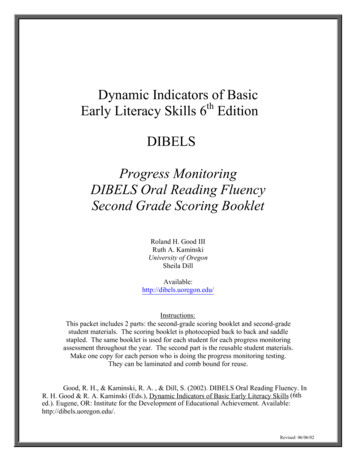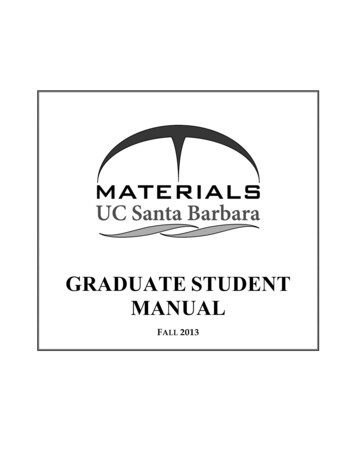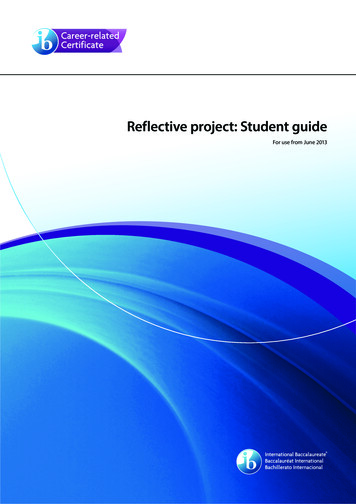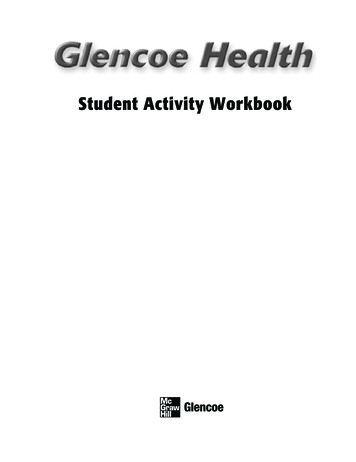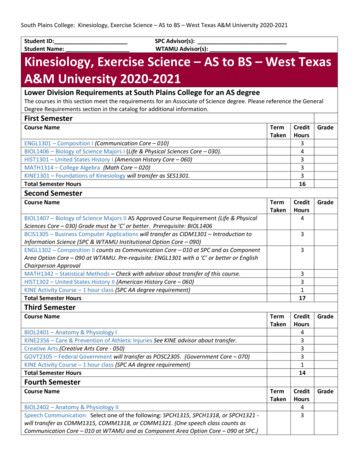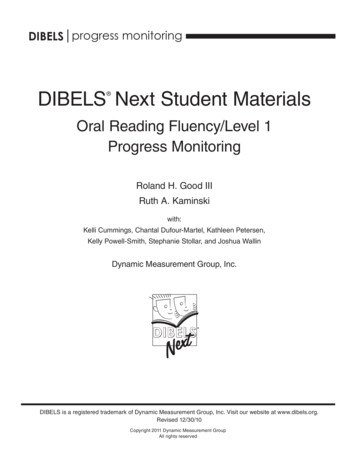
Transcription
DIBELS progress monitoringDIBELS Next Student Materials Oral Reading Fluency/Level 1Progress MonitoringRoland H. Good IIIRuth A. Kaminskiwith:Kelli Cummings, Chantal Dufour-Martel, Kathleen Petersen,Kelly Powell-Smith, Stephanie Stollar, and Joshua WallinDynamic Measurement Group, Inc. Benchmark 3DIBELS is a registered trademark of Dynamic Measurement Group, Inc. Visit our website at www.dibels.org.Revised 12/30/10Copyright 2011 Dynamic Measurement GroupAll rights reserved
A Busy SaturdayThe morning light filled the room. Mel jumped out of bed and put onher clothes. She had a busy Saturday planned. She could not wait to getstarted.First, Mel and her mom made Mel’s favorite food. Her mom cuta banana in half. Then Mel spread peanut butter on both sides. Shebrought the two pieces together and ate her banana sandwich outsidein the sun.Soon Mel’s big brother came out with some chalk. They drew a lineon the driveway. After putting on helmets, they skated along the line. Melwent very slowly. She was just learning to skate. Her brother helped herskate in a straight line and not fall down.Now it was time for art. Mel went to the art box. Her mom oftenfilled it with fun things. Mel got an idea when she saw some socks. Shemade a dog puppet and a bird puppet out of the socks. Then she wrotea play about them. She asked her brother and mom to come watch.They liked the show and clapped when it ended.That night, Mel helped her mom make dinner. Then she read a bookuntil it was time for bed. When Mel turned out the light, she thoughtabout all the fun things she had done.Benchmark 3DIBELS Progress MonitoringOral Reading FluencyPage 1L1/Progress Monitoring 1
Tap DanceIf you hear a song you like, you might tap your foot to the beat.Tapping the feet is a fun way to move to the music. It is no surprise thatfoot tapping turned into a dance. It is called tap dance. Tap dance haspeople use their feet to make sounds. The many sounds the feet makecome together to form a kind of song. This makes it fun to watch andlisten to tap.Tap dancers wear special shoes with metal plates on the bottom.The plates are called taps. When the taps hit the floor they make noise.Dancers move their feet around to make different noises. The moves arecalled steps. Each step has a different name. Some common steps arethe brush, stomp, and shuffle. When dancers first learn how to tap, theystart slow. When they get better, their feet will move faster. They mayalso learn very hard steps. These take a long time to master.Tap dance has been around for many years. Like many kinds ofdance, it has changed over time. One great tap dance team called Slapand Happy added turns and even acrobatics. People became excitedto watch tap. Soon, tap appeared on TV and in movies. Thanks to themany shows that use tap, this kind of dance is still enjoyed to this day.Benchmark 3DIBELS Progress MonitoringOral Reading FluencyPage 2L1/Progress Monitoring 2
The Yellow SnakeJane was so happy. Her class was going on a field trip to ReptileGardens. There would be lots of snakes, lizards, and turtles. Some peopledo not like these kinds of animals, but Jane liked them best of all.The first thing Jane and her class saw when they got to ReptileGardens was a room filled with snakes. They were all different sizes andcolors. Jane thought they were very pretty. She saw a worker holdinga big snake. It was bright yellow. Jane had never seen a yellow snakebefore. The worker saw her watching and smiled at her.“Would you like to see what the snake feels like?” she asked. Janesaid yes and touched it gently. It was dry, smooth and cool. Janegrinned. This was great!Next the class went to a room that was full of giant turtles. Janewatched them as they swam in the water. They were a lot bigger thanthe snakes. She liked to watch the turtles, and wanted to touch one. Herteacher said that was not a good idea.All too soon it was time to go home. Jane was glad the ReptileGardens were close by. She knew she would come back again to seethe big yellow snake.Benchmark 3DIBELS Progress MonitoringOral Reading FluencyPage 3L1/Progress Monitoring 3
A Pancake BreakfastOn a school day, the morning can be very busy. Most people eatbreakfast foods that do not take much time to make. They might havecereal and milk or fruit with wheat toast. On the weekend, people arenot in a rush. They can eat foods that take longer to fix. You might like totry cooking pancakes when you have the time.To make pancakes, first you make the batter. Some people use a mixthat they buy from the store. They add eggs and milk. Other people donot use a mix. They put flour, salt, and sugar in a bowl. Then they add theeggs and milk. All these things together make the batter. Stir the batterjust a little bit. Too much stirring will make the pancakes heavy.Next, heat a big flat pan, and pour some batter into the pan.Bubbles pop up, which make the pancakes get big. The bubbles are filledwith air. The air makes the pancakes light and fluffy.Soon, the pancakes turn brown around the sides. It is time to turnthem over. They cook for a few more minutes. Then the cook puts all thepancakes on a plate.Now it is time to add something on top. Some people like syrup.Others like fruits, such as strawberries. There are lots of things you canput on pancakes. Adding the topping is the last step. Now you can eatyour tasty pancakes.Benchmark 3DIBELS Progress MonitoringOral Reading FluencyPage 4L1/Progress Monitoring 4
Picking ApplesThe apple farm was having a picking party. Ren and her family hadcome to enjoy the fun. Ren could see a hayride and a man paintingfaces. There was even a woman juggling five apples above her head.Ren wanted to pick apples first. She ran to the nearest tree. Smiling,Ren pulled off a big red apple. She opened her mouth wide. Crunch!As she took a bite, sweet juice ran down her chin. Ren quickly ate theapple. Now it was time to get to work. Ren filled her basket so she wouldhave lots of apples to eat at home.After picking red apples, Ren went to a tree that had green apples.These apples were not very sweet, but they made tasty pies and cakes.Ren got another basket. She picked as many apples as she could. Whenshe tried to lift the basket, Ren could not pick it up. It was too heavy.Ren’s mother smiled and asked her to get a wagon. Together, they putboth of their baskets on the wagon and pulled it to their car.The important work was done. Now Ren was ready to have fun. Shewent to get her face painted. Ren looked at all the pictures. Then shesaw the one she wanted. When the man was done painting, Ren had abig red apple on her cheek.Benchmark 3DIBELS Progress MonitoringOral Reading FluencyPage 5L1/Progress Monitoring 5
The Puppet ShowOur class took a trip to the public library to see a puppet show.Students from other schools were there, too. The puppet show was in aspecial part of the library where there were books and chairs just forchildren. A lady read the story while the puppets performed the story.Our class had so much fun! We asked our teacher if we could make apuppet show of our own and she said yes.When we got back to school we talked about ideas for a show. Weraised our hands to share ideas. We each waited our turn while ourteacher wrote the ideas on the white board. We talked about all of theideas. Then we voted for the best one. The class voted to make the showabout a trip to the library.Our class made puppets out of socks and paper bags. Some of thepuppets looked very silly. Mine had brown hair and red lips. Everyonehad a job to do. Some children planned what the puppets wouldsay. Other children made a stage out of a big box. We practiced theshow over and over. Then we did our puppet show for the children inpreschool. They loved it.Benchmark 3DIBELS Progress MonitoringOral Reading FluencyPage 6L1/Progress Monitoring 6
PuzzlesDo you like to solve puzzles? They can be a lot of fun. There aremany kinds of puzzles. For many people, the puzzle they like best is ajigsaw puzzle. In a jigsaw puzzle, you make a picture out of many smallpieces.The first jigsaw puzzle was made by a map maker. First he made amap of the world. Then he cut around each nation. People had to tryto put the pieces in the right place. Schools used this kind of puzzle toteach students where each nation of the world was located. It madelearning about the world fun.Next, a new kind of saw let puzzle makers cut puzzles into manysmall pieces. The pieces were often cut into odd shapes. Many morejigsaw puzzles were made. Then, they began to put fun pictures onthem. People wanted to see what the picture would look like when it wasdone.Today, you can buy many kinds of jigsaw puzzles. The hard oneshave lots of tiny pieces. Some have pictures on both sides. Some areshaped like ships or castles. Some even have clues hidden in the picture.Then you get to solve a picture puzzle and a mystery.Benchmark 3DIBELS Progress MonitoringOral Reading FluencyPage 7L1/Progress Monitoring 7
A Night at Grandma’s HouseThe car drove out the farm gate. Jon waved goodbye to his dad.Then he smiled at his grandma. He had been waiting all week to comespend the night with her. They always had so much fun together.First, Jon and his grandma fed the animals. He threw corn to thechickens and feed cubes to the cows. Then he gave hay and water tothe goats.“This animal is hungry now,” said Jon, pointing to himself.Grandma made macaroni and cheese for dinner. After eating, Jonwent to the orange room to play. It had been his father’s room longago. Jon got out some small cars and made a road of blocks to drivethem on.Grandma soon told Jon it was time for bed. He went to get hispajamas and bear out of his bag. Surprised, Jon found that he had lefthis bear at home. He wondered how he would be able to sleep.Grandma thought for a minute. Then she opened the closet andpulled out a white box. Jon saw a brown bear with a flat nose inside.Grandma explained that Jon’s father had slept with the bear when hewas young. The nose was flat because Jon’s father had used it as apillow.Jon held the bear close. Now he could go to sleep.Benchmark 3DIBELS Progress MonitoringOral Reading FluencyPage 8L1/Progress Monitoring 8
Go to SleepWhat do you do before you go to bed at night? You may read, play,or listen to a story. Then your mouth opens wide and you take in a bigbreath. You are yawning. That means it is time to go to sleep.Sleep is a time when the body gets to rest. You are not playing orworking. Most children sleep nine to twelve hours each night. The longresting time lets your body build up energy. Then you can work and playthe next day.When you sleep, your body changes. The beat of your heart slows.You do not breathe as fast. These changes help your body rest andrelax so it can grow. During this time your body also works to fix placesthat are hurt or sick.Sleep helps your mind, too. It lets your brain rest. The next day youare able to remember things more easily. Sleep can also help your brainsolve problems.As you can see, sleep is very important. It helps keep your bodyand mind healthy. The next time you yawn or feel tired, remember thatyour body may be telling you it needs to go to sleep.Benchmark 3DIBELS Progress MonitoringOral Reading FluencyPage 9L1/Progress Monitoring 9
Shape ArtIt was time for art. The teacher told the children that spring hadcome. He asked them to draw a picture of something that showed theseason.Jed put his hands in his lap. He did not think he knew how to draw.The teacher asked Jed what was wrong.“I am not good at drawing,” Jed said.“Think of everything you see as a group of shapes,” said the teacher.“A house has a square wall and a triangle roof. Just draw the shapes.”Jed looked out the window. He saw a tree that was just starting togrow new leaves. He looked at the tree to find shapes.First, Jed drew a long brown rectangle for the trunk. He drew morethin rectangles at the top of the trunk to make branches.Which shape could Jed use to make the leaves? He looked out thewindow again. Jed drew some green ovals on the branches.Jed had placed the tree in the middle of the paper. He thought itlooked funny. So Jed made a line under the trunk to show the ground.Now the tree needed roots. He drew long thin triangles at the bottom ofthe trunk.Something was still missing from Jed’s picture. He looked out thewindow and saw a red bird. Now Jed knew just what his tree needed.He drew a red bird with ovals for the head and body. Triangles madethe bill and wings. Jed titled his picture, “Spring tree.”Benchmark 3DIBELS Progress MonitoringOral Reading FluencyPage 10L1/Progress Monitoring 10
Watch Them Change and Grow“I see one,” said Grandfather. “Put the net in the water and scoophim up before he gets away!”Jill waited for the tadpole to swim close to the bank so that shecould reach him. Quickly, she leaned over and caught the little creaturein her net. She stared at it and watched it wriggle.“He will grow and change into a fine frog,” her grandfather said.“I want to keep him and see him change,” she said.Grandfather told Jill that she could keep him. “But, when he growsinto a frog, we’ll have to bring him back to the creek.”Jill and her grandfather made a home with a fish tank. They putrocks at the bottom. Water plants added food and color. Next, they filledthe tank with a little bit of water. Jill watched her tadpole change overthe next few weeks. First, he grew back legs, then he grew front legs. Histail became smaller and smaller each day. Jill charted his growth.One day it was clear that her pet had become a frog. It was timefor him to go back to the creek. Jill and her grandfather took him backand set him free. The frog jumped away happily.Jill grinned from ear to ear. “That’s a fine frog,” she said.“Well, would you look at this?” said Grandfather.“A caterpillar!” Jill replied. “Can I keep him? I want to see himchange and grow!”Benchmark 3DIBELS Progress MonitoringOral Reading FluencyPage 11L1/Progress Monitoring 11
ClamsA clam is an animal that lives in the sea. A clam has two hard shellsthat cover a soft white body. A muscle holds the two shells together sothey can open like a door. It helps open and close the clam shell. Theclam opens the shell to eat. It closes the shell to be safe.You may have never seen a clam. That is because they live buriedin the sand of the ocean floor. Clams hide in the sand for safety. Theyhave one foot, which they use to dig a hole in the sand. It is not like yourfoot. It is all one piece and does not have toes. The foot digs a hole bymoving back and forth. The clam digs about two inches into the sand.Clams often stay in this hole their whole life.To eat, clams push two tubes through the sand. One tube pulls inwater and food. The other pushes out waste.Sea otters eat clams if they can find them. They swim down to theocean floor and dig in the sand for clams. Then the otter swims back upto the surface. Finally, the otter uses a rock to crack open the hard shell.Most clams grow to be one to three inches long. Some grow tomore than five feet long. These giant clams weigh up to 500 pounds. Anotter would have a hard time eating a clam that big!Benchmark 3DIBELS Progress MonitoringOral Reading FluencyPage 12L1/Progress Monitoring 12
The Talking StoneThe teacher gathered the students into a circle. He held up a whitestone in his hand.“This is a talking stone,” he told his students. “It helps us take turns soeveryone has a chance to talk and a chance to listen. If we all speakat once, no one can hear. We can use the stone to help us. If you havethe stone, it is your time to talk. If you do not have the stone, it is yourtime to listen. This way we can share, and everyone can hear.”Then the teacher asked the students to share something specialthey had done that day.Jen raised her hand quickly. She wanted to share something that noone else would share. She wanted to talk about feeding the lizard. Whenthe teacher passed the stone to another child, Jen put her hand down.It was her turn to listen.The stone moved slowly. One girl talked about drawing pictures inart. Another boy talked about counting seeds in math. No one talkedabout the lizard.Soon Tom held the stone. He sat beside Jen. Tom pointed to thelizard and told how he helped feed it. Then he passed the stone to Jen.Jen took the stone. She could not think of anything special to say.Jen looked at the stone. Then she knew what to say.“I liked passing the talking stone,” Jen said. “It helped me rememberall the fun things we did today.”Benchmark 3DIBELS Progress MonitoringOral Reading FluencyPage 13L1/Progress Monitoring 13
The Kite ContestIt was kite day at the local park. Everyone Jim knew had a kite tofly. Jim had made the kite he would use. It was shaped like a triangle. Hehad painted an eagle on it. He knew that an eagle was a bird that flewvery high. He hoped that his kite would fly high, too.When Jim and his dad got to the park, Jim lifted his kite up. He feltthe tug on the line and let the string out. The wind pulled the kite higherand higher. Before long, most of the string was gone. Jim saw that theend was not tied to the tube.He tried to grab the string before the kite got away. Suddenly, a gustof wind yanked the string right out of his hand. The kite was flying away!Jim chased after it, trying to grab the loose string.When the kite sailed over a tree, the string got caught on one ofthe branches. Happily, Jim saw that the kite kept bobbing in the wind. Hewould be able to save his kite after all.A man walked over to Jim. “We’ve never had a tree fly a kite,” hesaid. “You get the prize for finding a special way to fly a kite.” The mangave Jim a prize!Jim’s dad reached up and grabbed the string. The kite came loose.Jim tied the string to the tube. He didn’t want to lose his kite again.Benchmark 3DIBELS Progress MonitoringOral Reading FluencyPage 14L1/Progress Monitoring 14
Dad’s SurpriseIt was a great day for a sailboat ride. Meg put on her life vest andclimbed into the boat. Dad pulled on a rope to lift the sail. The wind filledthe cloth and pushed the boat away from the dock. Meg leaned overthe side of the boat to feel the water. A wave splashed on her face.Meg laughed as she wiped the water out of her eyes.Meg loved sailing with her dad. Each Saturday, they would sail to aspot on the other side of the lake. Dad would bring ham sandwiches forlunch. They would eat them as they sat on the sand. If it was a hot day,Meg and Dad went for a swim.The boat had not gotten to the other side of the lake yet, but Dadlet down the sail. The boat stopped. “I have a surprise for you,” Dad said.He got out a fishing rod and tossed the line into the water. He gave therod to Meg and she smiled. She had never been fishing. Soon, she felt abig tug.“I caught something!” Meg yelled. She pulled a big fish onto theboat. Dad gave her a high five.Then Dad raised the sail again and the boat began to glide acrossthe water. Soon they arrived at the shore. Dad made a small fire tocook the fish. They had fish for lunch. It was a great picnic.Benchmark 3DIBELS Progress MonitoringOral Reading FluencyPage 15L1/Progress Monitoring 15
Kinds of HatsA hat sits on top of the head. There are many kinds of hats. Somehats have special jobs, and some hats are just for fun.A hard hat keeps the head safe. It is made out of plastic. Housebuilders wear this kind of hat. Things that fall cannot hurt their heads.Firefighters also use a hard hat. Their hats have a wide brim on the backto keep fire and heat away. You also wear a hard hat when you ride abike. That hat is called a helmet.Many workers wear hats that show the job they do. Some of thesehats are made of cloth. Police officers wear a flat hat that is the samecolor as their uniform. Chefs wear tall white hats when they cook.People use different hats to match the weather. Wool hats fit closelyover the head. They keep the head and ears warm in the
DIBELS Progress Monitoring Page 1 Benchmark 3 Oral Reading Fluency L1/Progress Monitoring 1 A Busy Saturday The morning light filled the room. Mel jumped out of bed and put on her clothes. She had a busy Saturday planned. She could not wait to get started. First, Mel and her mom made Mel’s favorite food. Her mom cut a banana in half.
